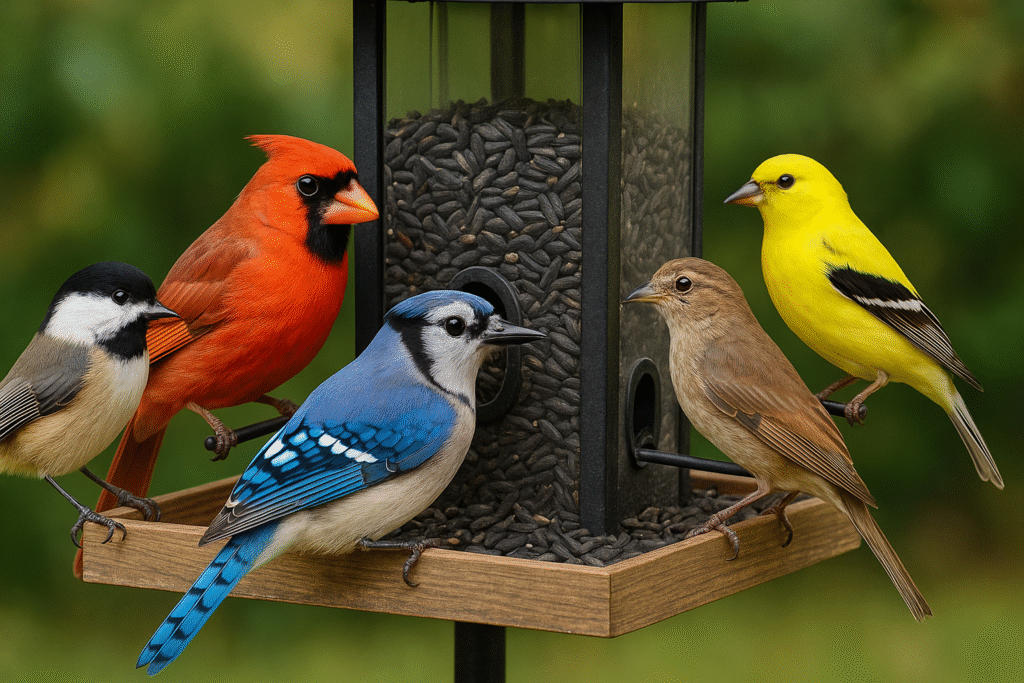Songbirds and How to Feed Them: A Backyard Guide for Bird Lovers

Welcome the Music of Nature to Your Backyard
There’s something magical about sipping your morning coffee while listening to the cheerful warble of a goldfinch or the melodic call of a robin. Songbirds aren’t just pretty faces in the trees—they’re nature’s tiny performers, putting on a free concert every day. With the right setup, you can turn your yard into a year-round stage for these feathered friends.
Whether you’re a seasoned backyard birder or just starting out, this guide will show you how to attract, feed, and care for songbirds using smart DIY tips, quality feeders, and the right food choices.
Why Feed Songbirds?
- Pest Control: Many songbirds snack on insects, helping keep your garden naturally balanced.
- Pollination Assistance: Birds like hummingbirds and orioles help pollinate flowers while they feed.
- Educational Fun: A great way to teach kids (and grown-ups) about native wildlife.
- Stress Relief: There’s real science behind the mental health benefits of birdwatching. Plus, it’s cheaper than therapy!
Best Foods for Common Songbirds
Different birds like different snacks, and putting out the right food is key to attracting a colorful cast of characters.
| Songbird | Favorite Food | Pro Tip |
|---|---|---|
| Chickadees | Black oil sunflower seeds | Use a tube feeder to keep out larger birds |
| Cardinals | Safflower seeds, sunflower seeds | Tray or hopper feeders work best |
| Goldfinches | Nyjer (thistle) seeds | Use a special finch feeder with tiny ports |
| Blue Jays | Peanuts (unsalted, shelled or whole) | Offer in a platform feeder or peanut wreath |
| Robins | Mealworms, fruits, raisins | Provide on a flat surface or shallow dish |
| Wrens & Nuthatches | Suet, sunflower seeds, peanuts | Hang suet cages in shaded areas |
Choosing the Right Feeder
Let’s be honest: the right bird feeder is like choosing the right tool—it depends on the job. Here are the main types and when to use them:
- Tube Feeders: Great for smaller birds like finches, chickadees, and nuthatches. Keeps seed dry and clean.
- Hopper Feeders: Hold more seed, attract a wide range of birds including cardinals and grosbeaks.
- Platform Feeders: Best for larger birds or ground feeders like doves and jays. Easy to clean but more exposed to weather.
- Suet Cages: Perfect for winter feeding and insect-loving birds. Mount them securely to avoid squirrel raids.
Tips for Successful Songbird Feeding
- Location, Location, Location: Place feeders near trees or shrubs to offer shelter and protection.
- Keep It Clean: Dirty feeders spread disease. Scrub feeders every 2 weeks with a diluted bleach solution.
- Fresh Is Best: Avoid moldy seed and discard old food, especially in wet weather.
- Water Matters: A clean birdbath is just as important as food—especially in summer and freezing winters.
- Keep Squirrels Out: Use baffles, weight-sensitive feeders, or squirrel-proof designs (or just give them their own snack station—they’ll still try to rob the buffet).
Plant for the Birds
Bird feeders are great, but don’t stop there. You can boost your songbird appeal by planting native shrubs, berry-producing plants, and seed-bearing flowers like:
- Coneflowers
- Black-eyed Susans
- Elderberry
- Dogwood
- Serviceberry
It’s the landscaping equivalent of an “all-you-can-eat” sign.
Final Word from the Helpful Hardware Guy
Feeding songbirds is like hosting a potluck for your feathered neighbors—they’ll come back for seconds if you serve the good stuff. With a little knowledge and a few simple tools (yes, pun intended), you can turn your yard into the hottest bird hangout on the block.
So grab a feeder, toss in some seed, and let the concert begin!
